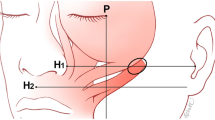Abstract
Purpose
The use of the masseteric nerve develops in the surgery of facial paralysis rehabilitation. The objective of this study was to determine the topography of the masseteric nerve and to deduce and predict a precise and reproducible anatomical cluster to facilitate its clinical identification during V–VII neurotization surgery.
Method
For the purpose of this work, a cadaveric study was performed on 31 hemi-faces. All dissections were performed bilaterally and comparatively, following steps aiming at simulating, as close as possible, the clinical conditions of a facial palsy rehabilitation by V–VII anastomosis.
Result
For the identification of the masseteric nerve, bony reference points were used, i.e., the temporomandibular joint (TMJ) and the chin point (CT). A virtual axis was drawn between the TMJ and the CT, and the distance [TMJ–MN] determining the smallest length h was then plotted against the distance [TMJ–CT] determining the largest length H, thus allowing the calculation of an h/H proportion ratio (PR) indicating the proximal part of the masseteric nerve from the TMJ. The average length h between the TMJ and the NM was 3.5 cm (± 0.1 cm) from the TMJ, i.e., an average ratio h/H [TMJ–MN]/[TMJ–CT] of 28.1% 4.0 and a median ratio of 28.6% of the distance [TMJ–CT].
Conclusion
Our study opens new perspectives for facilitating its identification and use, offering practitioners a tool to make V–VII the neurotization procedure less complex, with the eventual prospect of a minimally invasive procedure combining imaging, surgery, and augmented reality.


Similar content being viewed by others
References
Pons Y, Gauthier J, Dagain A, Conessa C, Clement P, Desgeorges M, Poncet JL (2009) Résultats à long terme de la réhabilitation des paralysies faciales périphériques par anastomose hypoglosso-faciale termino-terminale [Long-term results of facial palsy’s rehabilitation by end-to-end hypoglossal-facial anastomosis]. Rev Laryngol Otol Rhinol (Bord) 130(3):169–174 (French. PMID: 20345073)
Chuang DC, Lu JC, Chang TN, Laurence VG (2018) Comparison of functional results after cross-face nerve graft-, spinal accessory nerve-, and masseter nerve-innervated Gracilis for facial paralysis reconstruction: the Chang Gung experience. Ann Plast Surg 81(61):21–29. https://doi.org/10.1097/SAP.0000000000001327
Scaramella LF (1975) Anastomosis between the two facial nerves. Laryngoscope 85(8):1359–1366. https://doi.org/10.1288/00005537-197508000-00012
Spira M (1978) Anastomosis of masseteric nerve to lower division of facial nerve for correction of lower facial paralysis. Preliminary report. Plast Reconstr Surg 61(3):330–334. https://doi.org/10.1097/00006534-197803000-00004
Biglioli F (2015) Facial reanimations: part I—recent paralyses. Br J Oral Maxillofac Surg 53(10):901–906. https://doi.org/10.1016/j.bjoms.2015.06.023
Biglioli F (2015) Facial reanimations: part II—long-standing paralyses. Br J Oral Maxillofac Surg 53(10):907–912. https://doi.org/10.1016/j.bjoms.2015.07.001
Collar RM, Byrne PJ, Boahene KDO (2013) The subzygomatic triangle: rapid, minimally invasive identification of the masseteric nerve for facial reanimation. Plast Reconstr Surg 132(1):183–188. https://doi.org/10.1097/PRS.0b013e318290f6dc
Angspatt A, Pannanusorn C (2018) The masseteric nerve: an anatomical study in Thai population with an emphasis on its use in facial reanimation. Asian J Surg 41(5):486–489. https://doi.org/10.1016/j.asjsur.2017.08.003
Davis RA, Anson BJ, Budinger JM, Kurth LR (1956) Surgical anatomy of the facial nerve and parotid gland based upon a study of 350 cervicofacial halves. Surg Gynecol Obstet 102(4):385–412 (PMID: 13311719)
Haynes S, Chau MN (1993) Inter- and intra-observer identification of landmarks used in the Delaire analysis. Eur J Orthod 15(1):79–84. https://doi.org/10.1093/ejo/15.1.79
Song F, Hou Y, Sun G, Chen X, Xu B, Huang JH, Zhang J (2016) In vivo visualization of the facial nerve in patients with acoustic neuroma using diffusion tensor imaging-based fiber tracking. J Neurosurg 125(4):787–794. https://doi.org/10.3171/2015.7.JNS142922
Benmahdjoub M, van Walsum T, van Twisk P, Wolvius EB (2021) Augmented reality in craniomaxillofacial surgery: added value and proposed recommendations through a systematic review of the literature. Int J Oral Maxillofac Surg 50(7):969–978. https://doi.org/10.1016/j.ijom.2020.11.015
Sun Y, Luebbers HT, Agbaje JO, Schepers S, Vrielinck L, Lambrichts I, Politis C (2013) Validation of anatomical landmarks-based registration for image-guided surgery: an in-vitro study. J Craniomaxillofac Surg 41(6):522–526. https://doi.org/10.1016/j.jcms.2012.11.017
Acknowledgements
The authors sincerely thank those who donated their bodies to science so that anatomical research could be performed. Results from such research can potentially increase mankind's overall knowledge that can then improve patient care. Therefore, these donors and their families deserve our highest gratitude. We would like to thank the Anatomy Laboratory of Amiens and all those people who contributed to the realization of this anatomical work. We also want to thank Mr MARMET Romain (medical student at the University of Picardie Jules Verne) for having granted us his work of production of Figure 1.
Funding
The authors declare that they have no conflict of interest and did not receive support from any organization for the submitted work.
Author information
Authors and Affiliations
Contributions
AC: protocol development, data collection, analysis, and management/manuscript writing. JB: protocol development data collection, analysis, and management/manuscript writing. MO: project development. SD: project development. ST: project development, manuscript writing. All authors contributed to the study and read and approved the final manuscript.
Corresponding author
Ethics declarations
Ethics approval
This study is in compliance with local ethical standards and in accordance with the ethical standards as laid down in the 1964 Declaration of Helsinki and its later amendments.
Additional information
Publisher's Note
Springer Nature remains neutral with regard to jurisdictional claims in published maps and institutional affiliations.
Rights and permissions
About this article
Cite this article
Caillouey, A., Bettoni, J., Olivetto, M. et al. Masseteric nerve position on the “temporomandibular joint–chin tip” artificial axis: an anatomical study. Surg Radiol Anat 44, 1017–1023 (2022). https://doi.org/10.1007/s00276-022-02972-1
Received:
Accepted:
Published:
Issue Date:
DOI: https://doi.org/10.1007/s00276-022-02972-1




